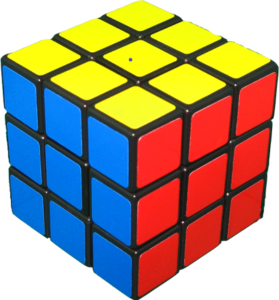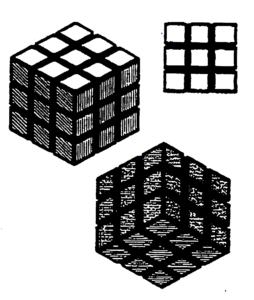Trade mark protection for creative product – Rubik’s Cube
The case: The English company Rubik’s Brand Ltd has had trade mark protection for the shape of the well-known Rubik’s Cube since 1999. The product had great success in the market. Then, in 2006, the competitor Simba Toys filed an application for cancellation of the trade mark.
Six decisions were issued. The first three decisions upheld the trade mark protection. The last three decisions, however, led to the cancellation of the trade mark in 2020 – 21 years after trade mark protection was granted. Why was this case so controversial?
The Rubik’s Cube is a rotating puzzle invented in 1974 by the Hungarian Ernö Rubik. An internal mechanism allows the individual-coloured cubes to be moved. The aim is to bring them back into order with the same colour on each side, as shown below:

Rubik’s Brand had the shape of the cube protected by the following colourless trade mark in the European Union:

Simba Toys objected, arguing that the trade mark consists exclusively of the shape of a product which is necessary to achieve a technical effect. Trade mark protection cannot be granted for such signs. Trade mark law does not allow the protection of purely technical and utility characteristics.
But is that right?
No, said the first three courts. The image of the mark did not show that the grid structure and the small squares fulfilled a technical function. The fact that there was a rotating mechanism in the cube was not obvious. Circumstances that do not result from the image of the mark itself cannot be used to assess the mark.
The European Court of Justice disagreed. Circumstances outside the trade mark were also relevant in order to be able to assess the real function of the elements of the product depicted in the trade mark. Otherwise, trade mark protection could easily lead to an undesirable monopoly in terms of the technology and utility properties of the product.
The grid structure visible in the image actually depict the columns of the rotating mechanism, which serve the item’s function as a three-dimensional puzzle, while the small cubes are inseparably connected to it. All essential elements of the depicted shape of the cube have a technical function. The illustration of the product shape did not show a single essential element that did not have a technical function.
It was irrelevant that the coloured areas of the cube were also required to achieve the technical effect in full, and also irrelevant that this aspect could not be gleaned in detail from the graphic representation of the product. It was sufficient for all the essential features of the graphic representation of the product to indicate a technical effect, even if the product also had other features with a technical effect.
Court of Justice of the European Union, 23 April 2020, C-936/19 P.
Learnings: If you have trade mark protection for a product shape, check whether all the essential elements of the graphic representation of the mark are necessary to achieve a technical effect. The technical effect of these elements may also result from circumstances which the graphic representation does not show. It is possible that the only options available in terms of direct protection of your product are the time-limited ones of patent protection and utility model protection.
See also the article:
Protection against counterfeiting – ground anchors